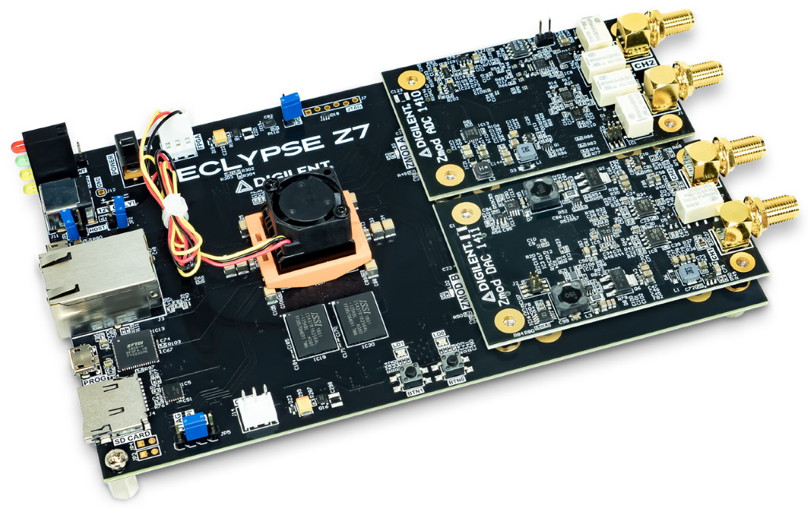Big Things in Store for Digilent in 2020
February 06, 2020
Story

National Instruments (NI) acquired Digilent in 2013. Now a key member of NI's family of companies focused on engineering education, Digilent operates as a wholly owned subsidiary.
Based in Pullman, Washington, Digilent has historically been associated with the academic space. Now, while continuing to support its existing markets, the company is exploring a new frontier with its latest product offering – the Eclypse Z7, a new open and customizable hardware and software ecosystem.
A Little Bit of History
Founded in 2000 by two Washington State University electrical engineering professors, Clint Cole and Gene Apperson, Digilent's original mission was to make electrical engineering and design technologies understandable and accessible to all by supplying educators and students with high-value, industry-relevant educational tools and curriculum.
National Instruments (NI) acquired Digilent in 2013. Now a key member of NI's family of companies focused on engineering education, Digilent operates as a wholly owned subsidiary.
Cole and Apperson succeeded beyond their wildest dreams. Digilent designs, manufactures, and distributes its products globally, and these products can be found in over 2000 universities in more than 70 countries. As a multinational company with offices in the US, China, and Romania, Digilent is renowned for providing high-quality, high-value solutions. In addition to its own products, Digilent provides OEM design and manufacturing services for leading technology companies, including Xilinx, Analog Devices, Cypress Semiconductor, and National Instruments.
Why Embedded Measurement?
Most people who have heard of Digilent associate the company with academia and with instrumentation products like its multi-function Analog Discovery 2 and Digital Discovery, in addition to its introductory development boards like the Basys 3 and Nexys Video. These FPGA-based offerings have long been Digilent’s wheelhouse, and through the years the company has developed extensive expertise in both FPGAs and test instruments, along with the very popular software WaveForms (used in the Discovery products).
However, as more RF communications, test, software-defined radio (SDR), and other similar applications that employ high-speed analog inputs and/or outputs where real-time signal processing is critical are becoming more popular with professional engineers, so is the need for higher precision and higher speed solutions. That’s why Digilent is looking into the so-called “embedded measurement” space. Digilent is aiming to harness its unique knowledge of FPGAs, USB instrumentation, and software to fill the existing void of products that do all three areas well.
Embedded measurement isn't a fully developed space right now, which makes it all the more exciting for Digilent and its users. It touches on all of the latest and greatest application areas and market segments, including the Internet of Things (IoT), the Industrial IoT (IIoT), software-defined radio (SDR), products equipped with artificial intelligence (AI) and machine learning (ML) capabilities, and devices targeting virtual reality (VR), augmented reality (AR), and mixed reality (MR). Digilent’s vision in 2020 and beyond is to create products that address these applications with its new embedded measurement ecosystems like the Eclypse Z7.
It's a New World: The Eclypse Z7
At the beginning of 2020, Digilent introduced its first offering to be fully targeted at embedded measurement applications, the Eclypse Z7. Featuring a Xilinx Zynq-7000 SoC FPGA, the board is designed to facilitate systems that are ultra-high-speed and highly modular.
In addition to two Pmod connectors for Pmod expansion, the Eclypse Z7 also boasts two SYZYGY standard interface connectors—which supports data rates of up to 500 MHz—for Zmod expansion. The first of Digilent’s SYZYGY-compatible add-on boards, the Zmod ADC 1410 and Zmod DAC 1411, both offer 100-MSPS, 14-bit conversion.

The Eclypse Z7 (main board) carrying two Zmod modules (sold separately) (Image source: Digilent)
The hardware, however, is only part of the story of the Eclypse Platform. Petalinux is supported out of the box, and prebuilt Linux images are accompanied by a software API for bulk data transfer. This system allows new users to get started without touching the hardware until desired. Further, with support from a built-in high-level API, users can enjoy the benefits of hardware acceleration without having to directly interface with the FPGA.
Can you say SYZYGY?
The widely used Pmod interface (or peripheral module interface) is an open standard that was defined by Digilent. The Pmod's 6- and 12-pin connectors are inexpensive to implement, and the cost of the peripherals, of which there is a tremendous number of off-the-shelf offerings, is around $8 to $50. The only issue with Pmod is that it's focused on low-speed peripherals in the 1- to 50-MHz range.
At the other end of the spectrum is the ANSI/VITA standard known as FMC (FPGA Mezzanine Card). Although FMC can support high-performance peripherals with data rates up to 10 Gbps, its 72- and 200-pin connectors are much more expensive, and the peripherals themselves can cost anywhere from hundreds to thousands of dollars.
The astronomical term “syzygy” refers to three celestial bodies being in alignment, such as the Earth, Moon, and Sun during a solar or lunar eclipse. Similarly, SYZYGY, which was defined by Opal Kelly, is an open standard for connecting high-performance peripherals to FPGA hardware that falls in the Goldilocks Zone (aka “just right”) aligned between Pmod and FMC in terms of price and performance.
The Future is Now
Having built a solid, trusted, and enviable reputation in academia, Digilent is poised to enter a new stage in its evolution by targeting the embedded measurement space with platforms like the Eclypse Z7 and its associated ecosystem.
The combination of the Eclypse Z7 with Pmod and Zmod expansion cards addresses the needs of professional engineers involving in the prototyping, design, verification, and test of the products that are going to drive the next decade. Make sure to visit Digilent to see a live demo of the Eclypse Z7, as well as their new “kitchen sink” Ultrascale+ board, the Genesys ZU at Embedded World in booth 3-610 in Hall 3.




